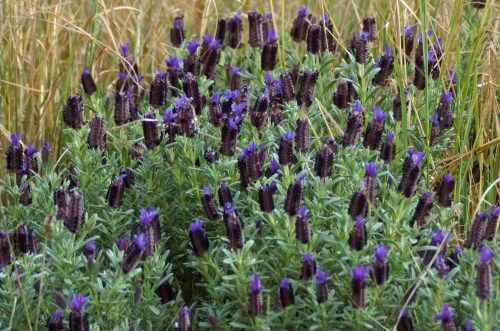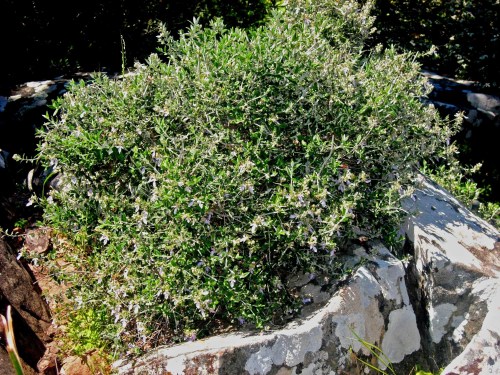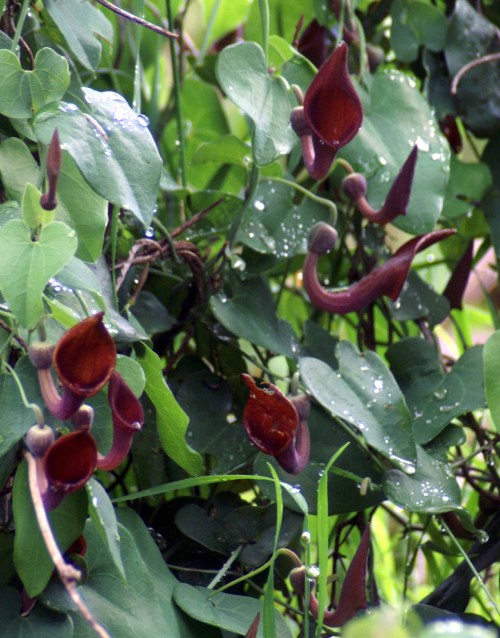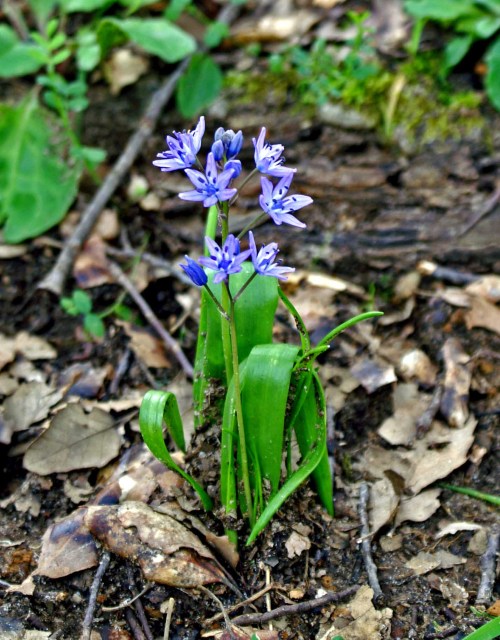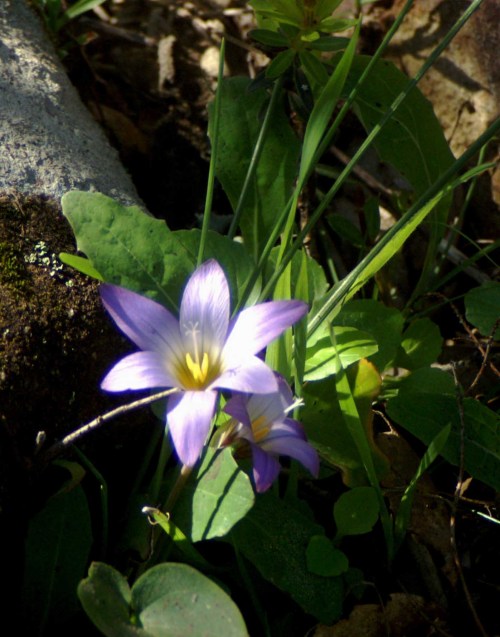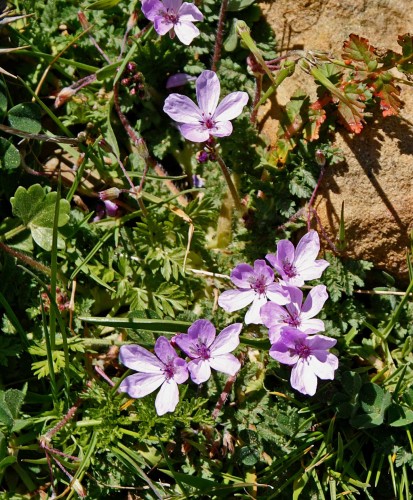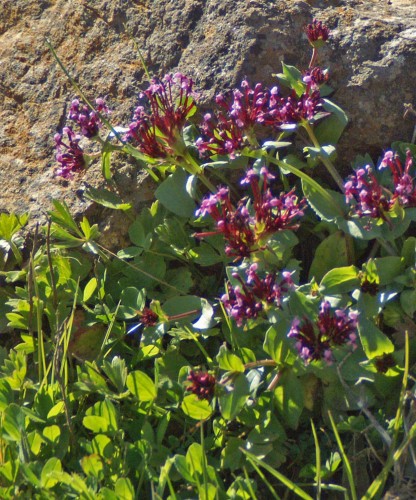7th March 2011
Following last Saturday’s high the week’s temperatures rapidly descended back to winter lows and we had rainy days, climaxing over the weekend with torrential downpours and thunderstorms. I have only ventured out for short walks during pleasanter parts of days, so for now I thought I’d do an update on some of the most commonly found plants that are presently flowering throughout the region.
Beautiful flowering shrubs and plants, many of which are widely cultivated and grown, or attempted to be grown in gardens throughout Europe, flourish here in some seemingly inhospitable places. Most thrive in a variety of different habitats, on dry sandy and often stony soils, in salty air by the sea and on rocky slopes. The plants compensate for the lack of available moisture with leaves that help to conserve it, these may be thick and felted, tough and leathery or needle-like. Many also protect themselves from being eaten by grazing animals with sharp spines or by producing chemicals that make them unpalatable. They flower early in the season to allow time to set seed before the summer drought begins.
Shrubs
SPINY BROOM – Calicotome villosa
Flowering: February to April (May)
Habitat: Open spaces, especially dry hillsides with Genista and Gorse bushes and often in coastal places close to the sea.
A very spiny shrub that is often confused with gorse. The flowers are a rich yellow colour, very scented and are so profuse that when they are fully out they hide the leaves. The flowers almost always come out at the same time and a mass of the shrubs growing together is a spectacular sight. The formidable spines are 3-4cm long, straight and tough, at the tips of the short leafy twigs and remain on dead wood.
*The spiny branches are so complexly interwoven that a stand of the shrubs is almost impenetrable and in the past, goatherds would cut bushes to use as fencing to corral their goats.
FRENCH LAVENDER – Lavandula stoechas
TREE GERMANDER: Teucrium fruticans
Flowering: January to June
Climbers
HABITAT: In almost any soil and a wide range of habitats, often in semi-shade on woodland edges, but also in more open places where it has support.
Dutchman’s Pipe is a robust, tall hairless creeping plant that will clamber high into trees, through shrubs or along the ground. The leaves are dull, blue-green and attractively heart-shaped.The flowers are about 7cm long, curved and a dull red-purple to brownish-red in colour: the plant takes its name from their curious shape that are designed to entice in insects to pollinate them, holding them captive until the job is done.
*The roots of the plant have been used in Spain since at least the 16th century for reducing fever.
____________________________________________________
Bulbs & corms
STAR OF BETHLEHEM – Ornithogalum orthophyllum (collinum)
FLOWERING: Feb/March to April/May
HABITAT: A variety of locations including light woodland, grassy roadsides, rocky ground and sandy coastal places.
A beautiful bulbous perennial with quite large star-shaped white flowers, 30-40mm across. Commonly cultivated.
ONE-LEAVED SQUILL, SCILLA – Scilla monophyllus
FLOWERING: Feb/March to April/ May
HABITAT: Light woodland, sandy and stony places.
A pretty, delicate-looking small bulbous perennial that produces a single long basal leaf that often bends over from the middle so the tip reaches the ground. The flowers are bright blue and star shaped, 7-9mm across and are held in compact spikes of 1-12 florets.
ROMULEA-Romulea bulbicodium
FLOWERING: January to March, April in the hills
HABITAT: Not fussy- sandy, stony or heavy rocky soils, open places or in light woods, coastal; very common.
Small, slender plants growing from corms, resembles a small crocus but does not have the deep green leaves with the central white line. Flowers open in the sun and range in colour from almost-white or pale lilac-pink to deep lilac.
____________________________________________________
Pretty but pestilential
BERMUDA BUTTERCUP – Oxalis pes-caprae
FLOWERING: December to early May, later in hills.
HABITAT: Nearly everywhere, mainly open places, but can quickly become a pest in gardens too; covering fields and roadsides in vast patches and quick to take hold on disturbed ground. In our area it grows in any soil from the coast to limestone crevices at least to 500m.
This enormously successful plant, (not related to buttercups), is a native of South Africa that has naturalised in most Mediterranean countries, in Portugal, Florida & Bermuda and is ever-increasing its range. It does look pretty when it cloaks fields with its soft primrose-yellow coloured flowers, but it is a serious pest, covering many acres of agricultural land. The plants contain oxalic acid are not eaten by domestic animals. It is seriously difficult to eliminate as it has bulbs deeply buried in the ground, and new methods of controlling it are being sought.
____________________________________________________
Herbaceous plants
COMMON ASPHODEL- Asphodelus aestivus
FLOWERING: January to March, April
HABITAT: Very common and widespread on rocky slopes, waste ground, woodland clearings, open coastal areas.
A tuberous perennial that often forms extensive colonies as it is unpalatable to grazing animals. (See post -GONHS trip to La Janda) This is a very robust plant with tall stems that can attain 1.5m or more in height. The flowers are white, 20-30mm across and the tepals have a pink-brown mid-vein. they are born in a much branched inflorescence that resembles a candelabra.
* The roots bear spindle-shaped tubers that are rich in starch, they are just edible and have been used as food in the past; they were also used to make glue.
ANDALUZ STORKSBILL – Erodium primulaceum
HABITAT: Sands, gravel and grassy fields; amongst scrub and in light woods; common across lowlands to hills.
A delightful, small annual plant that may grow to 30cm but is frequently smaller. The leaves are deeply cut and fern-like; the flowers are supported by long thin stalks with 2 to as many as 6 heads to each. Individual flowers are about 2-2.5cm across, with two petals larger than the other three, each having a dark pink mark near its base. The colour of the flowers ranges from pale to mid-pink, occasionally white. In early spring it can be more conspicuous when it forms large patches of pink in fields and on roadsides.
FIELD MARIGOLD – Calendula arvensis
FLOWERING: Almost all year round, but mainlyJanuary to May/June
HABITAT: Sandy, stony soils, often favouring disturbed and cultivated ground. Widespread across the region.
An annual plant with tiny flowers, 1-2cm across that range in colour from bright yellow to orange.
FEDIA – Fedia cornucopiae
FLOWERING: December right through to April/May
HABITAT: Grassy roadsides, damp pastures and disturbed ground.
A small, low-growing and spreading annual, very common and widespread plant and having a very long flowering period. The leaves are oval, quite a dark green and hairless. Flowers are borne on stems that branch into two at their end, with two leaf-like bracts at the joint; each stem then bears a densely clustered flower-head. Flowers are about 1.5cm long pink to dark red in colour.
BORAGE-Borago officianalis
FLOWERING: February to May.
HABITAT: Country roadsides, seasonally damp fields in sandy or rubbly soil; often cultivated; mainly located in lowlands.
An annual plant that grows to about 70cm tall, it is much-branched with hollow stems. All parts of the part except the petals are covered with short, sharp and pale-coloured hairs. The leaves have a puckered surface and are variable in size. The deep blue flowers are held face-down on short bent stalks and are almost scentless, which is a pity as they are quite beautiful.



